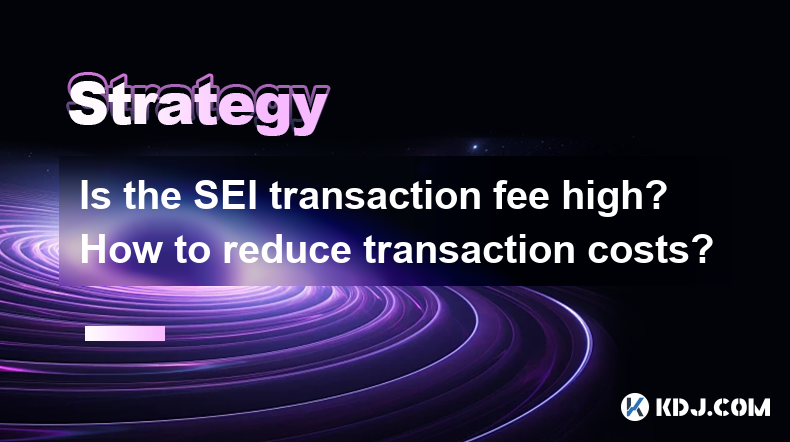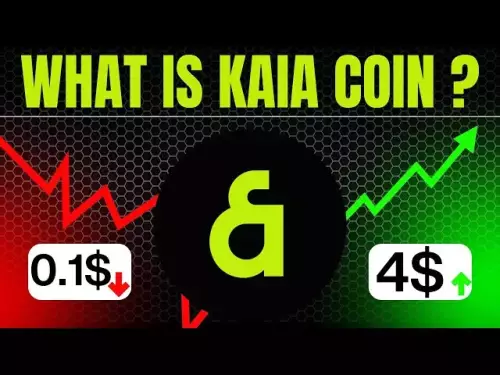-
 bitcoin
bitcoin $112715.707551 USD
-1.71% -
 ethereum
ethereum $4101.475385 USD
-3.01% -
 tether
tether $1.000644 USD
-0.02% -
 bnb
bnb $1207.619465 USD
-6.77% -
 xrp
xrp $2.501451 USD
-3.98% -
 solana
solana $202.947124 USD
-3.32% -
 usd-coin
usd-coin $1.000295 USD
0.04% -
 dogecoin
dogecoin $0.203884 USD
-4.47% -
 tron
tron $0.317154 USD
-1.72% -
 cardano
cardano $0.695009 USD
-4.43% -
 hyperliquid
hyperliquid $38.853961 USD
-8.23% -
 chainlink
chainlink $18.988674 USD
-4.64% -
 ethena-usde
ethena-usde $1.000233 USD
-0.03% -
 stellar
stellar $0.337050 USD
-3.63% -
 bitcoin-cash
bitcoin-cash $536.861728 USD
-1.28%
Is the SEI transaction fee high? How to reduce transaction costs?
SEI blockchain offers low base fees, but costs can rise with network demand; users can save by timing transactions, optimizing size, using Layer 2, and gas oracles.
May 01, 2025 at 06:00 pm

The SEI blockchain, known for its high-performance and low-latency capabilities, has become increasingly popular among users in the cryptocurrency ecosystem. One of the key concerns for users interacting with any blockchain is the transaction fee, as it directly impacts the cost-effectiveness of using the network. In this article, we will delve into whether the SEI transaction fee is high and explore various strategies to reduce transaction costs.
Understanding SEI Transaction Fees
Transaction fees on the SEI blockchain are typically determined by a combination of factors, including network demand, transaction size, and the complexity of the operations being performed. Unlike some other blockchains where fees can fluctuate wildly based on network congestion, SEI aims to maintain a more predictable fee structure.
The base fee for a standard transaction on the SEI network is generally considered to be relatively low compared to other major blockchains. However, during periods of high network activity, the fees can increase due to higher demand for block space. This is a common phenomenon across many blockchains and is not unique to SEI.
Factors Influencing SEI Transaction Fees
Several factors can influence the transaction fees on the SEI network:
- Network Congestion: When there is a high volume of transactions waiting to be processed, users may need to pay higher fees to have their transactions prioritized.
- Transaction Size: Larger transactions, which may include more complex smart contract interactions, can incur higher fees.
- Gas Prices: SEI, like Ethereum, uses a gas mechanism to measure the computational effort required for transactions. Higher gas prices can lead to higher transaction fees.
Understanding these factors is crucial for users looking to minimize their transaction costs on the SEI network.
Strategies to Reduce SEI Transaction Costs
There are several effective strategies that users can employ to reduce their transaction costs on the SEI blockchain:
1. Timing Your Transactions
One of the simplest ways to reduce transaction fees is to time your transactions during periods of lower network activity. By avoiding peak times, you can take advantage of lower gas prices and reduced competition for block space.
- Monitor the SEI network's activity using blockchain explorers or analytics tools to identify periods of low congestion.
- Schedule your transactions during off-peak hours, typically during the night or early morning in your time zone.
2. Optimizing Transaction Size
Reducing the size of your transactions can also help lower fees. This involves minimizing the number of operations and the amount of data being processed in a single transaction.
- If you need to perform multiple operations, consider breaking them into smaller, separate transactions to reduce the overall fee.
- Use batching techniques where possible, grouping similar transactions together to share the fixed cost of a single transaction.
3. Using Layer 2 Solutions
Layer 2 solutions, such as sidechains or off-chain transaction protocols, can significantly reduce transaction costs by processing transactions outside the main SEI blockchain and then settling them in batches.
- Research and choose a reputable Layer 2 solution that is compatible with the SEI network.
- Follow the specific instructions provided by the Layer 2 solution to move your transactions off the main chain and back, ensuring you understand the associated risks and benefits.
4. Leveraging Gas Price Oracles
Gas price oracles are tools that provide real-time recommendations on the optimal gas price to use for your transactions, helping you avoid overpaying for transaction fees.
- Use a reliable gas price oracle service that is specifically designed for the SEI network.
- Adjust your transaction settings based on the oracle's recommendations to find the right balance between speed and cost.
Practical Steps to Lower SEI Transaction Fees
To implement the strategies mentioned above, follow these practical steps:
- Monitoring Network Activity:
- Visit a SEI blockchain explorer or analytics platform.
- Look for metrics such as transaction volume, block times, and average gas prices.
- Identify times when the network is less congested and plan your transactions accordingly.
- Optimizing Transaction Size:
- Review the operations you need to perform and see if they can be simplified or broken down.
- Use a wallet or dApp that supports transaction batching to group multiple operations into a single transaction.
- Setting Up Layer 2 Solutions:
- Research available Layer 2 solutions compatible with SEI.
- Follow the provider's instructions to set up your wallet or account on the Layer 2 network.
- Transfer your assets to the Layer 2 solution and conduct your transactions there.
- Once complete, settle your transactions back on the SEI mainnet according to the provider's guidelines.
- Using Gas Price Oracles:
- Choose a gas price oracle service that supports SEI.
- Configure your wallet or transaction interface to use the oracle's recommendations.
- Before sending a transaction, check the oracle's suggested gas price and adjust your transaction settings accordingly.
Common Tools and Services for SEI Transaction Management
Several tools and services can assist users in managing and reducing their SEI transaction fees:
- Blockchain Explorers: Platforms like SEIscan provide real-time data on network activity, helping users identify optimal times for transactions.
- Wallet Software: Wallets like SEI Wallet or MetaMask (if integrated with SEI) often include features for gas price optimization and transaction batching.
- Layer 2 Solutions: Services like Optimism or Polygon (if adapted for SEI) can be used to process transactions more cost-effectively.
- Gas Price Oracles: Tools such as GasNow or EthGasStation (if they support SEI) offer recommendations on optimal gas prices.
Frequently Asked Questions
Q: Can I set a custom gas price for my SEI transactions?A: Yes, most wallets and transaction interfaces that support SEI allow users to set a custom gas price. This can help you balance the speed and cost of your transactions. Always check the current network conditions and use gas price oracles to find the most suitable price.
Q: Are there any risks associated with using Layer 2 solutions on the SEI network?A: Yes, while Layer 2 solutions can significantly reduce transaction costs, they also introduce additional risks such as smart contract vulnerabilities and potential delays in transaction finality. It's important to thoroughly research and understand the specific risks of the Layer 2 solution you are considering.
Q: How can I tell if the SEI network is congested?A: You can monitor the SEI network's congestion by using blockchain explorers or analytics platforms. Look for indicators such as increased transaction times, higher gas prices, and a higher number of pending transactions in the mempool.
Q: Do all SEI wallets support transaction batching?A: Not all SEI wallets support transaction batching. You should check the features of your specific wallet or consider using a wallet that explicitly supports this functionality to optimize your transaction costs.
Disclaimer:info@kdj.com
The information provided is not trading advice. kdj.com does not assume any responsibility for any investments made based on the information provided in this article. Cryptocurrencies are highly volatile and it is highly recommended that you invest with caution after thorough research!
If you believe that the content used on this website infringes your copyright, please contact us immediately (info@kdj.com) and we will delete it promptly.
- XRP Price Prediction: Weekend Rollercoaster or Rally?
- 2025-10-12 08:45:16
- Bittensor (TAO): Super Bullish Signals Point to Potential 2x Rally
- 2025-10-11 10:25:12
- Silver Price Correction: Navigating the Dip & Identifying Key SEO Keywords
- 2025-10-11 10:25:12
- Decoding Crypto Trends: Bittensor's Bull Run, Cardano's Dip, and LivLive's Presale Buzz in 'Uptober 2025'
- 2025-10-12 08:45:16
- MoonBull: The Crypto Meme Coin Promising 1000x Gains?
- 2025-10-11 10:30:01
- Crypto Payroll Revolution: Stablecoins, Altcoins, and the Future of Salary Payments
- 2025-10-11 10:30:01
Related knowledge

Practical parameter settings for a Bitcoin multi-timeframe moving average system
Sep 18,2025 at 10:54pm
Optimizing Timeframe Combinations for Bitcoin Trading1. Selecting appropriate timeframes is crucial when building a multi-timeframe moving average sys...

How can I filter out false breakouts in Dogecoin high-frequency trading?
Sep 22,2025 at 01:00am
Understanding False Breakouts in Dogecoin Trading1. A false breakout occurs when Dogecoin's price appears to move beyond a defined support or resistan...

Techniques for identifying tops and bottoms in the Bitcoin on-chain NVT model
Sep 20,2025 at 07:54pm
Understanding the NVT Model in Bitcoin Analysis1. The Network Value to Transactions (NVT) ratio is often described as the 'P/E ratio' of the cryptocur...

What does the surge in open interest in Bitcoincoin futures mean?
Sep 20,2025 at 11:18pm
Understanding the Surge in Dogecoin Futures Open Interest1. A surge in open interest within Dogecoin futures indicates a growing number of active cont...

How can I use the Ethereum USDT premium to gauge market sentiment?
Sep 18,2025 at 11:55pm
Understanding the Ethereum USDT Premium1. The Ethereum USDT premium refers to the price difference between USDT (Tether) traded on Ethereum-based plat...

What should I do if Ethereum staking yields decline?
Sep 20,2025 at 06:18am
Understanding the Causes Behind Declining Ethereum Staking Yields1. The Ethereum network transitioned to a proof-of-stake consensus mechanism with the...

Practical parameter settings for a Bitcoin multi-timeframe moving average system
Sep 18,2025 at 10:54pm
Optimizing Timeframe Combinations for Bitcoin Trading1. Selecting appropriate timeframes is crucial when building a multi-timeframe moving average sys...

How can I filter out false breakouts in Dogecoin high-frequency trading?
Sep 22,2025 at 01:00am
Understanding False Breakouts in Dogecoin Trading1. A false breakout occurs when Dogecoin's price appears to move beyond a defined support or resistan...

Techniques for identifying tops and bottoms in the Bitcoin on-chain NVT model
Sep 20,2025 at 07:54pm
Understanding the NVT Model in Bitcoin Analysis1. The Network Value to Transactions (NVT) ratio is often described as the 'P/E ratio' of the cryptocur...

What does the surge in open interest in Bitcoincoin futures mean?
Sep 20,2025 at 11:18pm
Understanding the Surge in Dogecoin Futures Open Interest1. A surge in open interest within Dogecoin futures indicates a growing number of active cont...

How can I use the Ethereum USDT premium to gauge market sentiment?
Sep 18,2025 at 11:55pm
Understanding the Ethereum USDT Premium1. The Ethereum USDT premium refers to the price difference between USDT (Tether) traded on Ethereum-based plat...

What should I do if Ethereum staking yields decline?
Sep 20,2025 at 06:18am
Understanding the Causes Behind Declining Ethereum Staking Yields1. The Ethereum network transitioned to a proof-of-stake consensus mechanism with the...
See all articles


























![Staking ATH: How To Stake $ATH in October 2025 with 523% APY — [Step-By-Step Guide] Staking ATH: How To Stake $ATH in October 2025 with 523% APY — [Step-By-Step Guide]](/uploads/2025/10/15/cryptocurrencies-news/videos/staking-ath-stake-ath-october-apy-stepstep-guide/68eef94d80903_image_500_375.webp)















































